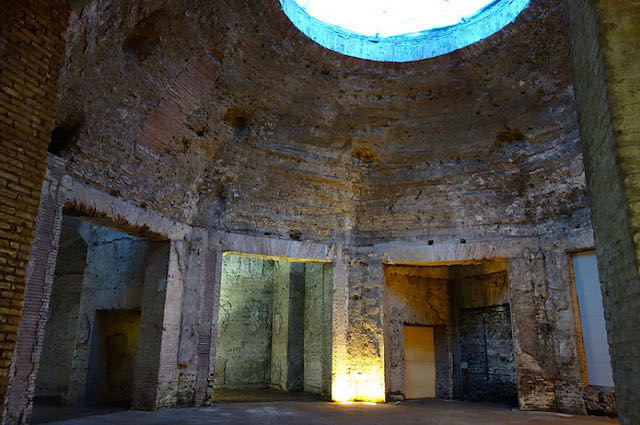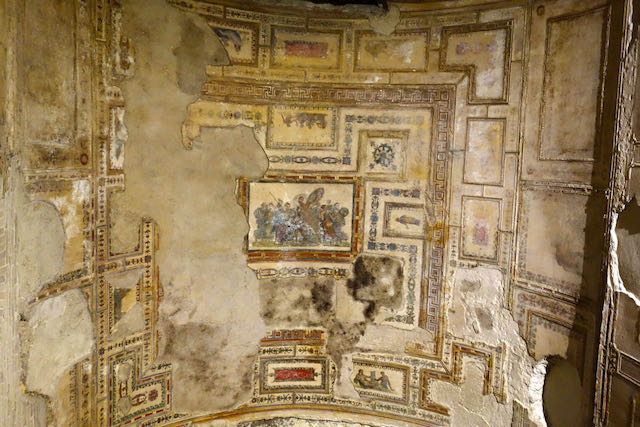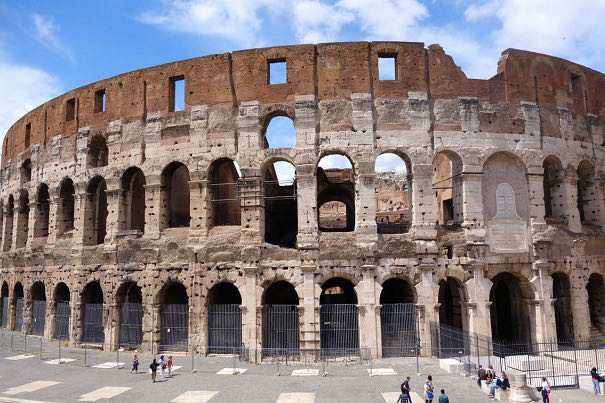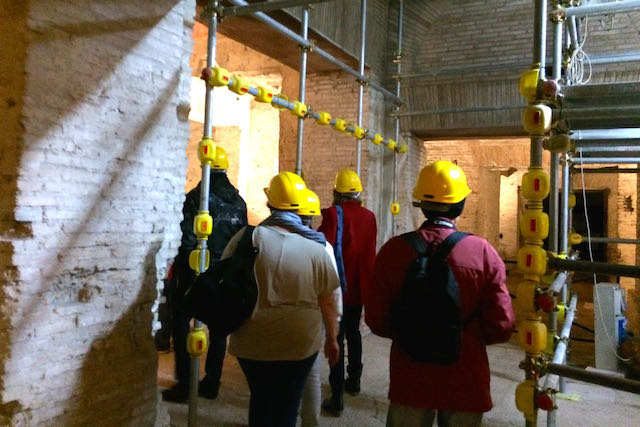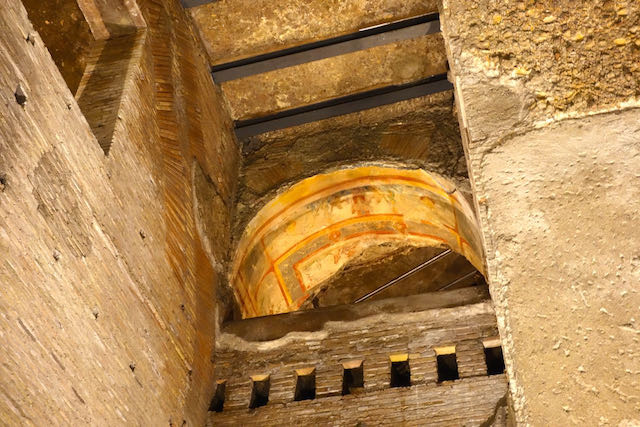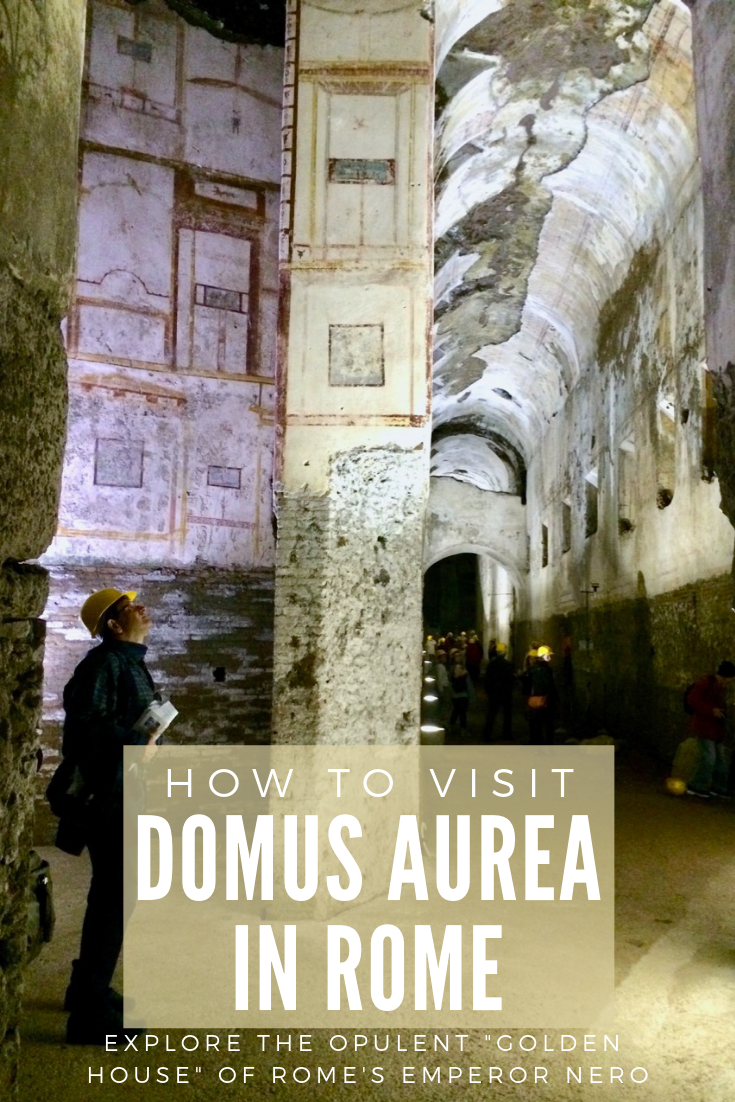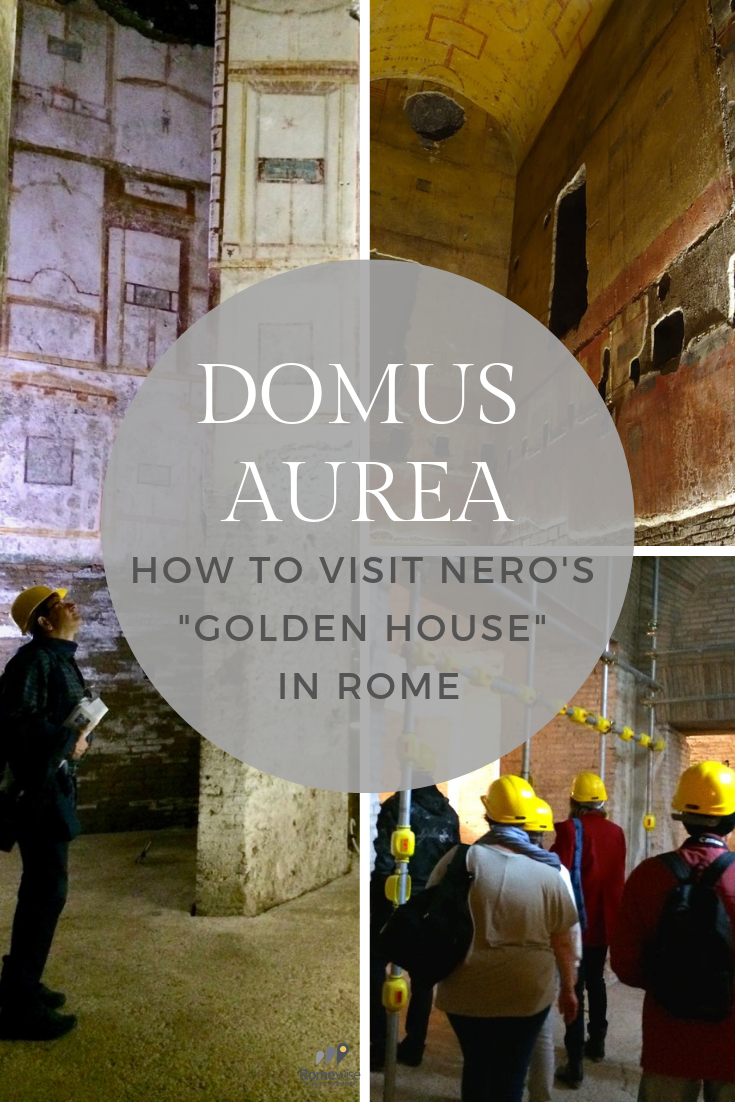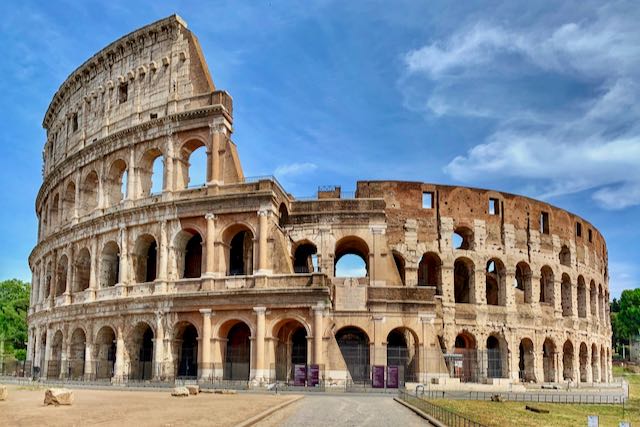- Sign up & get a FREE ebook Subscribe NOW!
Domus Aurea - Nero's Golden House
A Rome Must See!
The first time I visited the Domus Aurea in 2002, I knew I was lucky to see such an extraordinary site from Ancient Rome.
I couldn't believe we could go underground and visit this incredibly intact 2000-year old ruin, and see such vivid paintings and well-excavated rooms.
I was awed by the details I could see in the ancient artwork, and the octagonal room with oculus in the ceiling that was so clearly a precursor to the Pantheon.
Well, I was right.
It was short-lived.
They shut the whole site down to visitors due to too much exposure devastating the ruins.
I thought it was closed for good.
Since then, there has been a lot of work restoring the Domus Aurea.
And now?
It's become one of the most spectacular things you can do in Rome!
The Domus Aurea - What You Need to Know
- What is Nero's Golden House? Why visit it?
- What is it like to tour the Domus Aurea?
- How and when to visit and how to get tickets.
- Is the Domus Aurea wheelchair accessible?
- Where is the Domus Aurea?
What The Domus Aurea is and Why you Should See it
Picture Rome in 64 CE.
Nero is emperor.
Yet another fire sweeps through Rome (this happened a lot back then.)
This time, the 6-day fire destroys huge amounts of land across the Esquiline, Celian and Palatine Hills.
Once the fire is out, Nero figures it's the perfect opportunity to build his opulent house of gold.
Just for him (that is a lot of ego even for a Roman emperor!)
Nero's Golden House
Imagine a vast space, probably larger than 4 football fields, that has nature parks, marble-covered pavilions, statues, fountains, sculptures, and atria.
We are talking about a massive complex of buildings, man-made lakes, gardens, porticos, all glimmering with white marble, ivory and precious materials brought in from around the empire.
That villa became known as the Domus Aurea (literally, from Latin, "Golden House.")
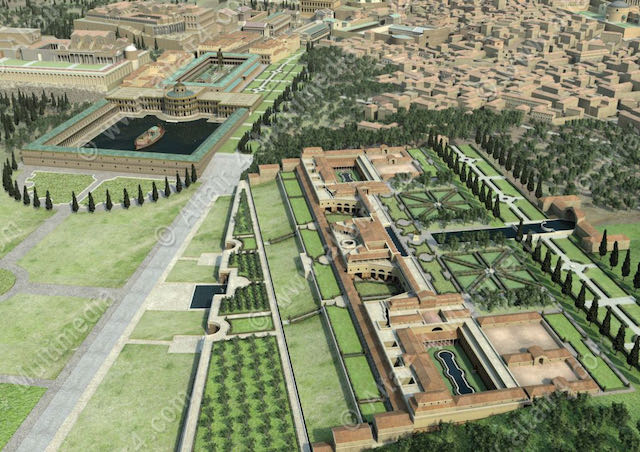 What Nero's Domus Aurea might have looked like in Ancient Rome. Photo source: Altair4.com
What Nero's Domus Aurea might have looked like in Ancient Rome. Photo source: Altair4.comA villa in Rome is not necessarily one building.
The word "villa" in this case usually refers to a large expanse of park space, or rather an estate, in which a wealthy family builds at least one if not many complexes to live in, entertain in, relax in, and just enjoy.
The Villa Borghese in Rome is an example of a "villa" that is in fact a huge park.
The Domus Aurea was anywhere from 100-300 acres.
Most of it has not been excavated but apparently it occupied much of the area we think of today as "Ancient Rome", i.e. the Palatine Hill, the Esquiline Hill and the Caelian Hill.
This includes where the Colosseum is now.
(During Nero's reign, the Colosseum had not yet been built.
There was a huge man-made lake there instead.)
Originally, it was thought that Nero's villa was simply a gigantic place for entertainment, as they had not found sleeping quarters.
But during one recent tour, the archeologist did in fact speak of possible sleeping quarters.
So much is still to be discovered about the use of all the spaces there.
Why "Golden House"?
Nero used gold leaf as decoration in many parts of the villa.
Also, most of the structures were composed of white, sparkling marble, and adorned with ivory and jewels.
And finally, the whole thing was exposed to streaming sunlight.
Today it's underground, but when Nero built and used it, it was on ground level.
So between the white marble, gold leaf, shimmering jewels, and the brilliant sunshine pouring in, the idea was to make this a "golden house."
A house that shined.
This fantastic website, Realm of History, does 3-D recreations of some of Ancient Rome's sites, as they might have been.
What happened to Nero's villa?
Nero was probably insane.
He'd killed his mother, killed his wife, and behaved pretty erratically.
In 68 CE he was driven out of the city and forced to commit suicide.
After his death, the senate issued a "Damnatio memoriae", a Latin phrase meaning "to condemn his memory."
In theory, Nero and all he did was to be obliterated so Rome could get back to being a stable, growing empire.
There was a shaky "year of the four emperors", where the first 3 after Nero kept getting killed one after the next.
But the fourth, Vespasian, who took reign in 69 CE, founded a stable dynasty: The Flavian dynasty.
One of Vespasian's ideas to help erase memories of Nero was to get rid of Nero's giant lake.
He said (something like), hmmm, let's fill in that pond and make a cool arena we can use for spectator sports.
The people will be amused and entertained and forget about all that craziness and instability.
This arena was known then (and still is) as the Flavian Amphitheater (named for the Flavian dynasty which Vespasian began.)
And eventually, it became known as the Colosseum, perhaps because of the colossal statue of Nero that stood there for a while.
Subsequent emperors (Titus and Domitian) built more things on top of the ostentatious ruins left behind by Nero, and finally, the Emperor Trajan, said, all right, this has all got to go.
(This was typical of emperors, and frankly, later, popes, who each wanted to leave his own mark on the city, and so, destroyed or built over what his predecessors had done.)
So Trajan had all the spaces filled with dirt and brick - which reinforced the walls and created a solid base - and built his baths on top.
Today you can see what's left of those baths in the Colle Oppio.
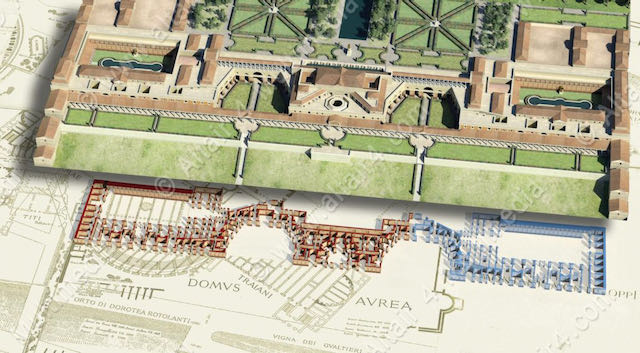 This sketch shows the visitable part of Nero's Domus Aurea, underneath Trajan's baths. Photo source: Altair4.com
This sketch shows the visitable part of Nero's Domus Aurea, underneath Trajan's baths. Photo source: Altair4.com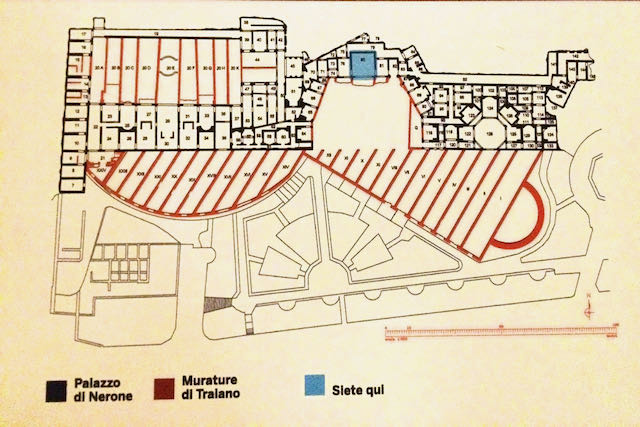 This map shows the outlines of Nero's Golden House in black, and the walls of Trajan's baths, above it, in red.
This map shows the outlines of Nero's Golden House in black, and the walls of Trajan's baths, above it, in red.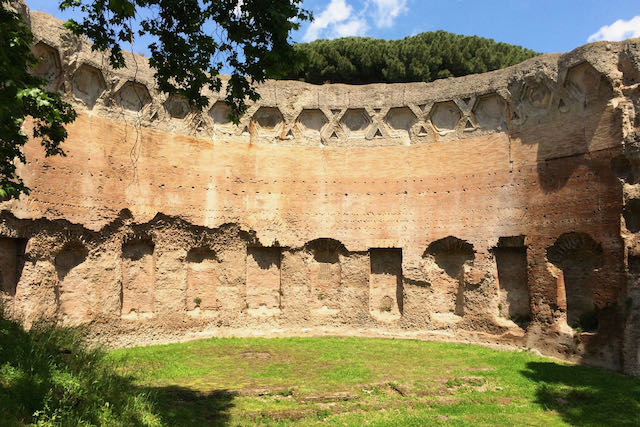 The remains of Trajan's baths in the Colle Oppio park. They sit directly above the Domus Aurea, which is now underground.
The remains of Trajan's baths in the Colle Oppio park. They sit directly above the Domus Aurea, which is now underground.This is one reason the area underground is so well preserved.
If Trajan had not had the placed filled in and reinforced, much of the architecture and art would probably have been long ago lost.
When the Domus Aurea was first discovered in the late Renaissance
I just love this story.
Apparently sometime in the Renaissance, a young Roman man fell into a crevasse in the ground, and found himself staring at ancient frescoes on the rubbly walls around him.
When word got out, the artists in Rome of the day, including Pinturicchio, Raphael and Michelangelo, all lowered themselves in there on ropes, and walked around on top of the rubble (put there by Trajan.)
They gazed at the art, and took with them ideas for their own works.
The style of art we think of today as Grotesque comes from this, because the artists said it was like being in a grotto, or cave.
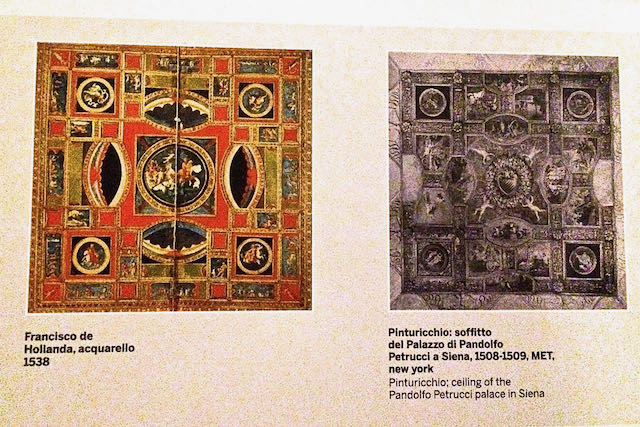 This is from a plaque inside the site, illustrating how the artists of the time were influenced by what they saw when the ruins were first discovered in the 1500's.
This is from a plaque inside the site, illustrating how the artists of the time were influenced by what they saw when the ruins were first discovered in the 1500's.The perfect 3-day itinerary in Rome
Trying to figure out how to organize your visit to Rome? I've got the perfect 3-day itinerary for first-time visitors (or those who have not been here in a while.) It works for a 2.5 day visit as well.
In my 3-day itinerary, you'll see all the major must-see Rome attractions like the Vatican, Colosseum, Trevi Fountain, Pantheon, Piazza Navona, Spanish Steps, and much more.
And if you have more time, or want suggestions for extra/other things to do, you'll find that there too.
Visit my page with the best 3-day itinerary in Rome for first-timers.
Influence on later art and architecture
A lot of what Nero did when he had his villa built influenced later art and architecture in Rome and in Italy.
For me, this is one excellent reason to visit the Domus Aurea- It really ties together Rome's ancient past with some of the things you may already have seen in Rome:
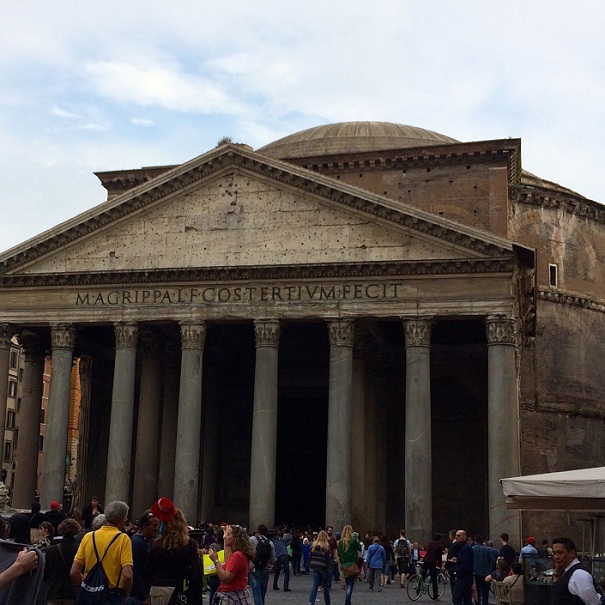
First of all, there is the octagonal complex, with its open oculus in the ceiling to allow light in.
Remind you of anything else in Rome?
Like the Pantheon?
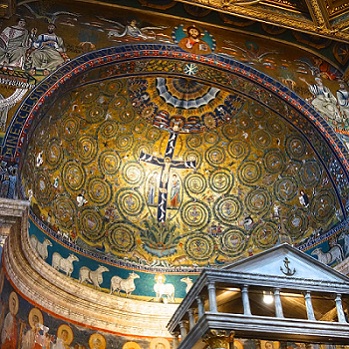
Second of all, Nero went against the trend at the time of laying mosaics only on the floor . . . and used them to decorate the ceilings as well.
Later, byzantine-style mosaics would be used this way to decorate church apses around Italy.
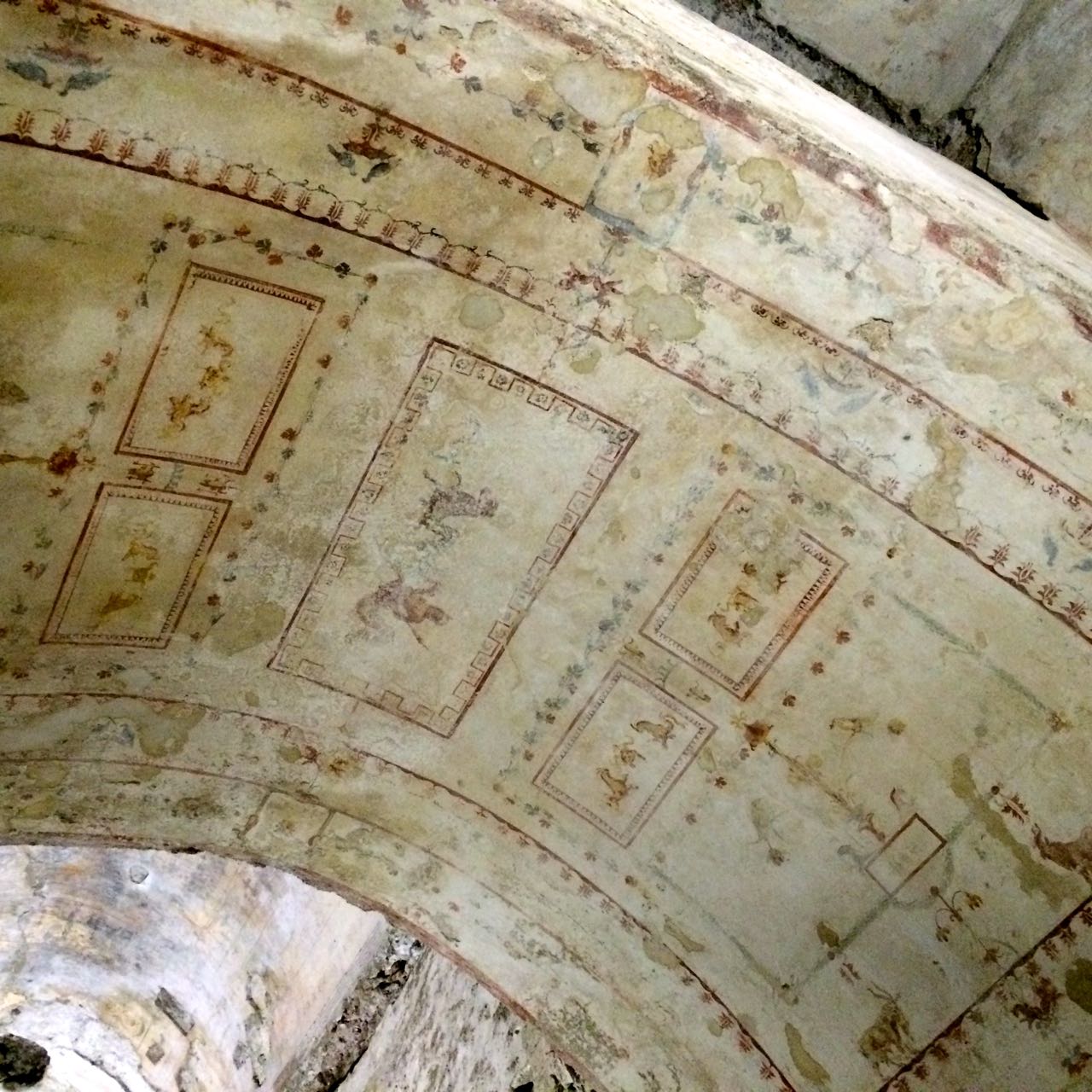
Third, the villa was rediscovered during the Renaissance (as I wrote just above), and many painters at the time took ideas from the paintings they saw on the walls there.
Most famously, Raphael's rooms in the Vatican take a lot from the designs he saw on the ceiling of the Domus Aurea.
An archeological site today
The Domus Aurea is today an active archeological dig and restoration project.
Luckily, we can visit these ruins, with a knowledgeable archeologist, who will give you an excellent and very thorough tour of the main catalogued and opened spaces of this vast underground complex.
It is really worth fitting this visit into a trip to Rome, and I would definitely classify it as a must-see in Rome, especially if you like the ancient stuff.
You get a much more intimate and closeup, and also un-crowded view of what once was the splendor of Nero's Rome.
What it's Like to Visit the Domus Aurea
I will just say "wow."
The Domus Aurea was already one of my favorite Ancient Rome things to see.
But now, with the addition of virtual reality goggles, this site visit has jumped to a whole new level of AMAZING!
When you first arrive for your visit, you will be given a hard-hat to wear.
I guess this is just a precaution, as I cannot see anything falling on you.
Even the guide will wear one.

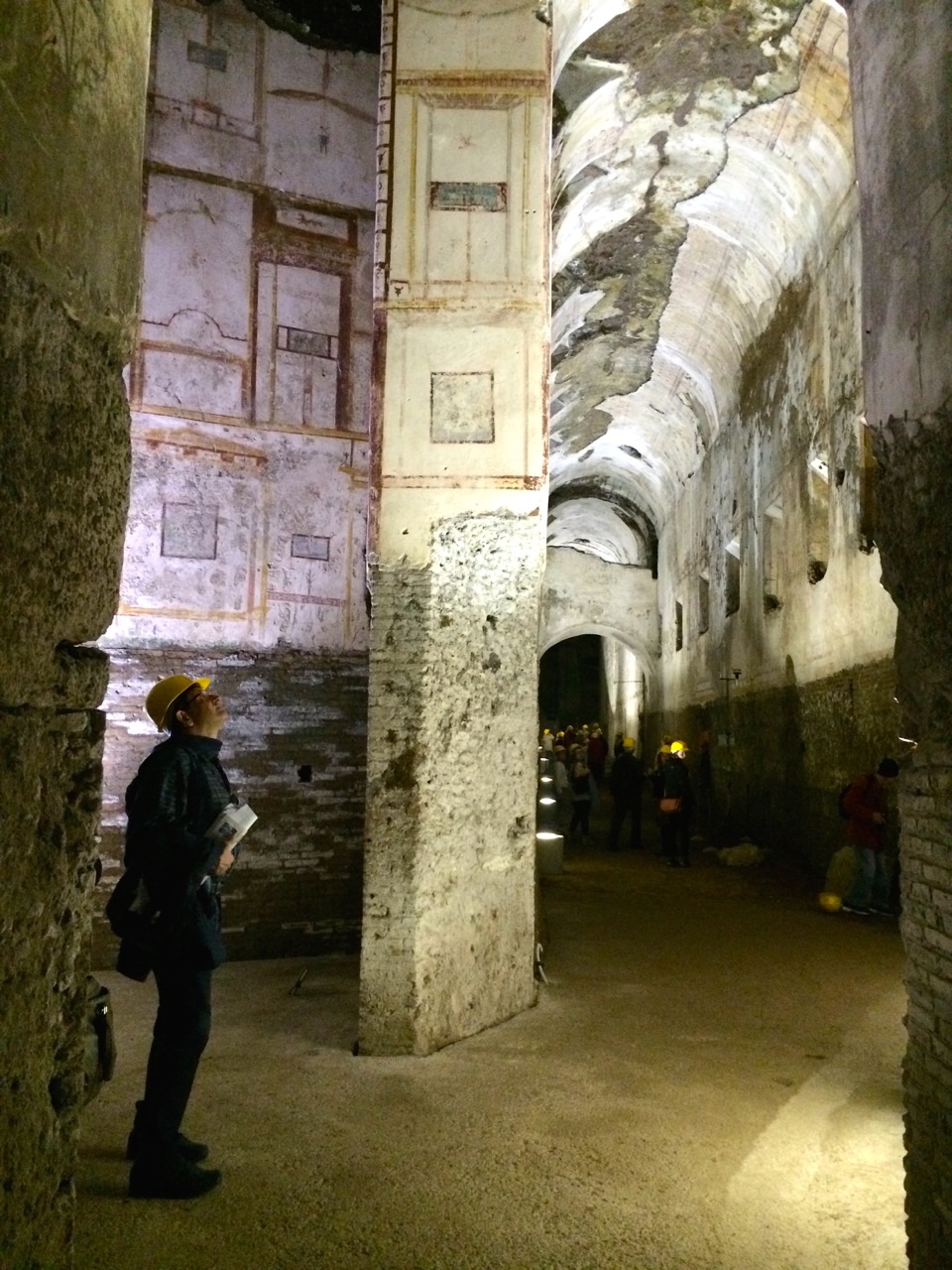
Your guide will be one of the archeologists actively working on the site.
So he/she is really in a position to know all the details.
In fact, each time I've done this visit over the years, the various guides have provided different and new information as more is discovered.
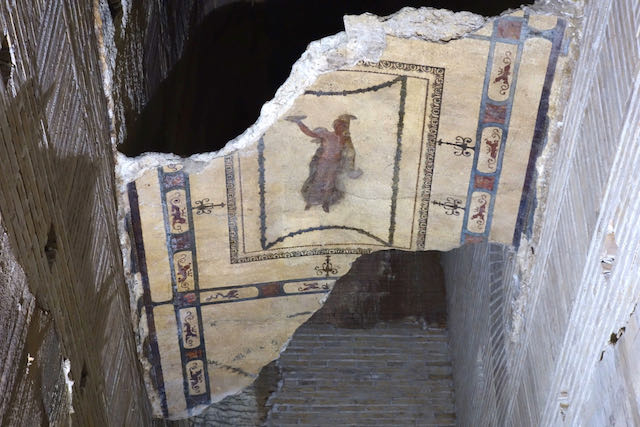 Grand and very fragile, the Domus Aurea is home to very delicate frescoes, painted plasters, and enormous rooms decorated with pomp.
Grand and very fragile, the Domus Aurea is home to very delicate frescoes, painted plasters, and enormous rooms decorated with pomp.The spaces are large, and it's not claustrophobic at all.
It is however, chilly in there.
And it can be damp in parts.
So if it's hot out, this can be a great way to keep cool!
Just remember to bring a sweater.
No matter what season you visit Rome, here are 4 essential things we recommend never leaving home without:
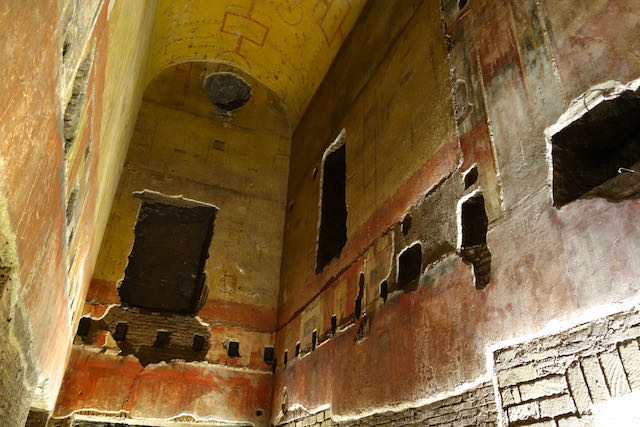 The Domus Aurea closed in 2006 due to the danger of collapses and structural failures. With the reopening to the public, you can even visit the western wing of secret pavilions, with rooms that were once inaccessible.
The Domus Aurea closed in 2006 due to the danger of collapses and structural failures. With the reopening to the public, you can even visit the western wing of secret pavilions, with rooms that were once inaccessible.In one of the rooms you will sit down and put on virtual reality goggles.
This is the part about the visit that makes the whole thing a must-see in Rome.
The narrator will take you through (in English) the ruins you are sitting in, but make it look as it did in the past.
You will feel transported, as if you are flying around and looking at the huge complex from a drone.
It's one of the most amazing things I've ever done in Rome and I cannot recommend this highly enough!
Ready to plan your trip?
Book your train
Planning to travel between cities in Italy and other parts of Europe?
Use Trainline to see all the different options available across the different rail companies.
Find your hotel
Find your perfect place to stay in Rome.
Use Booking.com to choose between hotels, guesthouses, and self-catering apartments in neighborhoods throughout the Eternal City.
Buy your TurboPass
Purchase the convenient Turbopass and visit all of Rome's top attractions including the Colosseum, Pantheon, and Vatican.
With one handy pass, it's all included.
How and When to visit
I cannot stress highly enough how you need to plan ahead for this.
And in high season, plan way ahead!
When to visit
The excavations are open to the public for guided tours only on Fridays, Saturdays and Sundays.
They are closed December 25, January 1, and May 1.
During the week, they are actively working on excavating and restoring the site, so you cannot visit it then.
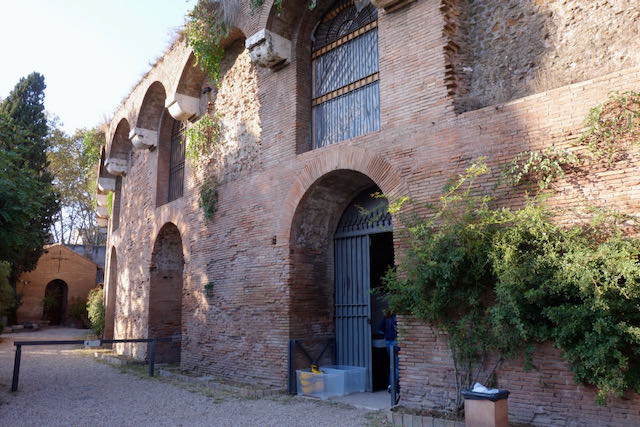 The entry to the Domus Aurea
The entry to the Domus AureaAs the guide explained to us on our tour, they finally re-opened it to visitors because, frankly, they need the money to help pay for these works!
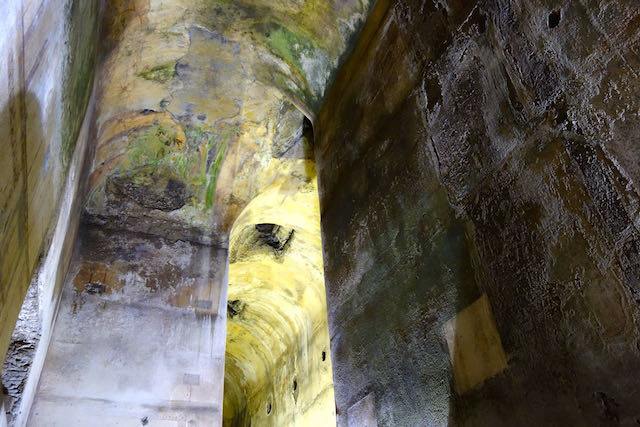 This is what humidity and time did to the walls inside the Domus Aurea
This is what humidity and time did to the walls inside the Domus AureaYou may visit on Fridays, Saturdays, and Sundays on a scheduled visit with an authorized guide from the site, between 9am and 5pm.
Appointments are available for groups of maximum 25 people, every 15 minutes, in English, Italian and Spanish.
Last admission at 3.45 pm.
The tour lasts about 1 hour and 20 minutes.
Want to see some other cool immersive light shows in Rome?
How to reserve tickets
Admission is 18€.
I strongly recommend pre-booking.
This is a very popular site, and although they are offering visits throughout the day on Fridays, Saturdays and Sundays, there is a maximum of 25 people allowed per visit, and you risk not getting in if you just show up.
Also, it's a good idea to book in the language you want.
The guides give a lot of information and speak quickly, so you will need to keep up!
The fee includes the guided tour and the virtual reality portion.
For tickets, visit Parco Colosseo
If they are sold out, you may try with a tour company (see below).
The Domus Aurea is not one of the sites available for free or reduced entry with the Roma Pass.
Also, it is not one of the sites that participates in the "Free Sunday at the Museum", held the first Sunday of each month, in which state museums and sites are free.
Colosseum Ticketing Update April 2024
A brand new ticket system has been launched for tickets to the Colosseum, Roman Forum, Palatine Hill and Domus Aurea - check it out here.
A few things to note with this new system:
1. It only applies for tickets from May 1 2024 onwards. If you want to purchase tickets for April 2024, you will need to use the old CoopCulture website.
2. Tickets are currently being released a month out, day by day. On April 8 tickets for May 8 became available, on April 9 tickets for May 9 get released and so on.
3. The new website has a system which puts visitors in a digital queue before letting them on to the site itself, to stop the site crashing due to demand, so don't worry if you don't get onto the site immediately.
4. Not all ticket/tour options are available to purchase yet so keep checking back if what you want isn't available.
Reserve Domus Aurea Tickets Through an Agency
Do you just want to book your Domus Aurea ticket and be done with it?
Have it arrive on your mobile device?
There is an easy way to do this, even if it costs a little more than booking through Parco Colosseo.
Is the Domus Aurea wheelchair accessible?
According to the Domus Aurea official website, Parco Colosseo, "The site is partially accessible to the disabled with wheelchair."
Since they are constantly excavating, and sometimes changing the itinerary, the accessible parts may also change.
Just be aware when booking that you may not be able to visit all the places covered on the tour.
Other important things to know regarding the use of the virtual reality goggles is that it is not recommended for children under 13, or to anyone with epilepsy or serious eye diseases.
Where to find the Domus Aurea in Rome
The Domus Aurea is on the Colle Oppio, just next to the Colosseum.
It is easily accessible from the Piazza del Colosseo, by walking through the gates of the Colle Oppio park.
Romewise's Top Travel Resources
Ready to book your trip to Rome? Take a look at these helpful links to companies we use and trust:
- Keep your travel spending simple with the Wise card, which removes all the worry about exchange rates and high transaction fees all over the world
- Search for and book your perfect accommodation
- Our complete guide to what to pack for Rome
- The number one travel accessory, a multi-point travel adapter and voltage converter
- Browse a huge range of tours in Rome and beyond
- Experience unique tours and special access to Rome's most popular sights
- Protect yourself with comprehensive travel insurance
Within this post there are some affiliate links for products and services. For more details about our affiliate policy click here.
Get your 100% free Rome trip planner now!
Simply sign-up today for our free newsletter and get the Romewise Quick Start guide to Rome:
We are committed to respecting your data. Click for our Privacy Policy.
Comments? Questions? Suggestions?
Please come over to the private Romewise Facebook group and join in the conversation.
You will often find me there, happy to answer your questions / comments!
You will also meet other Rome lovers and experts, too.
What are you waiting for?

